When we look at the beauty of the ocean, it is easy to appreciate how enchanting a humpback whale looks, especially as it jumps out of the water and falls back down. These whales are easily listed among the largest animals in the entire world. And second only to that of the blue whale in size.
Humpback whales can reach sizes of 40-100 tons (80,000-200,000 pounds) and lengths of 14.6-19 meters (48-62 feet long.) Although most humpback whales are closer to 40 tons, they can absolutely get larger, and we will see this at the end of the article, where we learn about the largest humpback whale ever to be recorded.
To keep up with their enormous size of 80,000+ pounds, humpbacks will consume a literal ton (2,000 pounds) of food daily. As omnivores, they will enjoy eating a diet of food such as the following:
- Krill
- Copepods
- Juvenile salmon
- Haddock
- Squid
- Zooplankton
- Mackerel
- Phytoplankton
- Herring
- Pollock
- Sand lance
- Sea snails
- Capelin
As you can see from this list, the plants, and animals that humpbacks eat are not large at all. Due to the humpback whales not having teeth, they have baleen plates that filter food from the water they consume. This makes it easy for them to eat the amount they need in a given day because they will just grab large mouthfuls, filter the water out, and swallow the food.
Now that we know how big a full-grown humpback whale adult can be, let’s dive into how big these animals are when they are born.
How Big Are Humpback Whales When They Are Born?

A humpback whale calf can grow about 100 pounds per day!
©iStock.com/CoreyFord
Humpback whales are polygamous, meaning they will have multiple mates in their lifetime. Humpback whales live very long and full lives, between 50 to 60 years. During this time, they will mate and reproduce every two to three years.
The mating season for male humpbacks is very aggressive. Once they are able to sense a female is in her breeding time, males will sometimes come from a great distance for the opportunity to mate with a female. The male courtship of the female will include things like rolling, flipping, and tail fluking.
Once the female has been impregnated, her gestation period will last a long 12 months. She will then give birth to a baby humpback whale which is called a calf. The ratio of male to female humpback births is 51.4% male and 48.6% female.
A calf will be born weighing as much as one ton (2,000 pounds) and reaching lengths of 10-15 feet long. To give you an idea of much this is, the average-size compact car will weigh about 2,600 pounds. So, a newborn calf will weigh about as much as a car would.
The calf will live with its mother for the next six months of its life. And sometimes, their connection with their mother will extend an additional six months if needed.
The calves will continue to double their size every year until they reach about 10 years old. They will also be fully sexually mature in four and five years from the time of their birth.
Now, the question becomes, are there different types of humpback whales, or are they the only ones?
Various Types of Baleen Whales
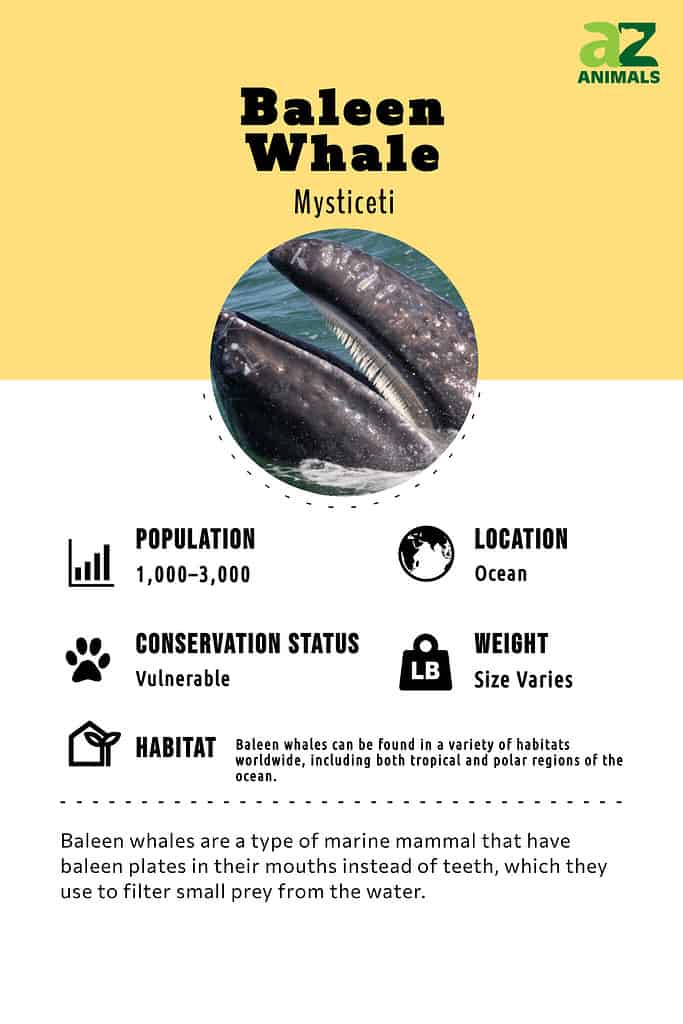
The humpback whale is a member of the baleen whales. And within the baleen whales category, there are three separate families: Balaenidae, Balaenopteridae, and Eschrichtiidae. They are called or rather categorized as baleen whales due to their teeth or lack thereof.
Baleen whales have what is called baleen plates that are their substitute for teeth. These plates are flexible, and the material is kreatin. Think of it like human hair and nails. Sounds creepy, right? Well, they use this as a filtration system when they are eating. They will often go to schools of fish and take large gulps. Their baleen plates will filter out the water and leave the reaming food in their mouths.
Of these three families, the humpback whales are rorquals and a part of the Balaenopteridae family. This family comprises humpbacks, blue, fin, Bryde’s, sei, and minke whales. Let’s jump into the deep end and discover how big these whales can get!
Blue Whale Size
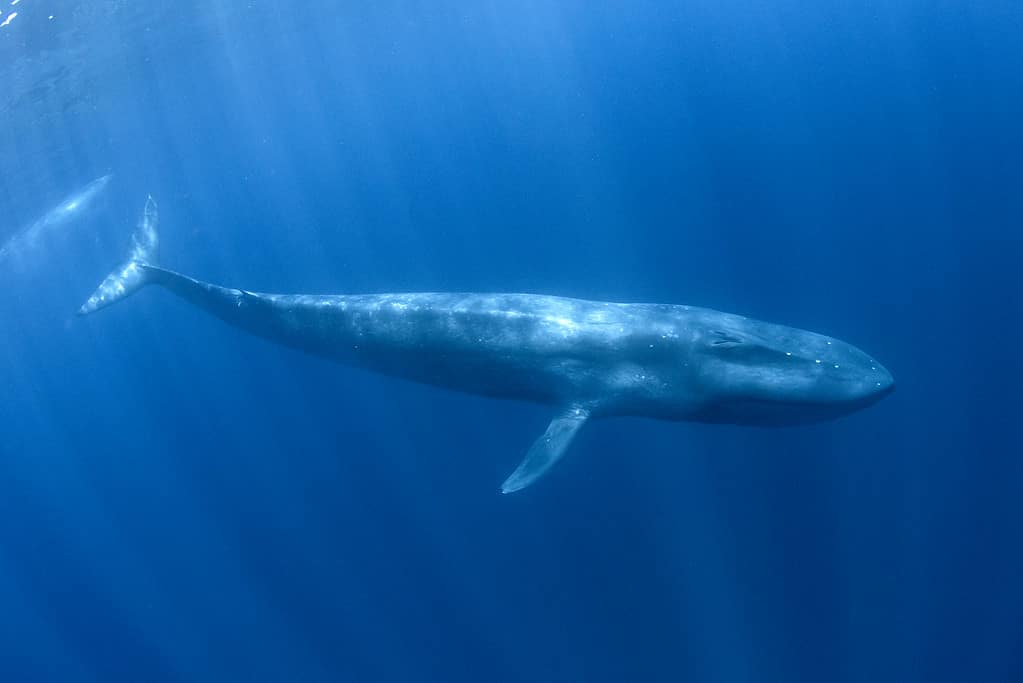
A blue whale’s tongue can weigh three tons (6,000 pounds).
©Rich Carey/Shutterstock.com
The blue whale is the largest animal in the world. These whales can weigh over 350,000+ pounds and reach 100+ feet.
Fin Whale Size
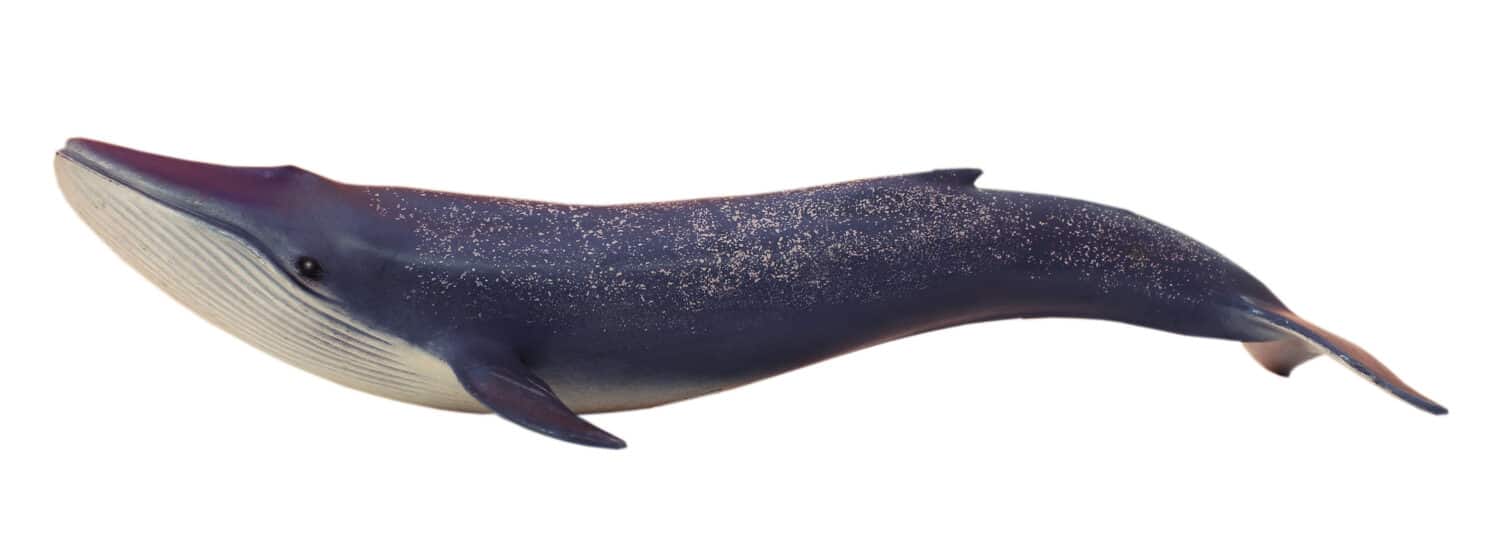
Fin whales have multiple stomachs used for consumption.
©Maria Spb/Shutterstock.com
The fin whale is also listed as one of the largest whales in the world as well. They can weigh between 4,000-150,000 pounds and reach up to 80 feet.
Bryde Whale Size
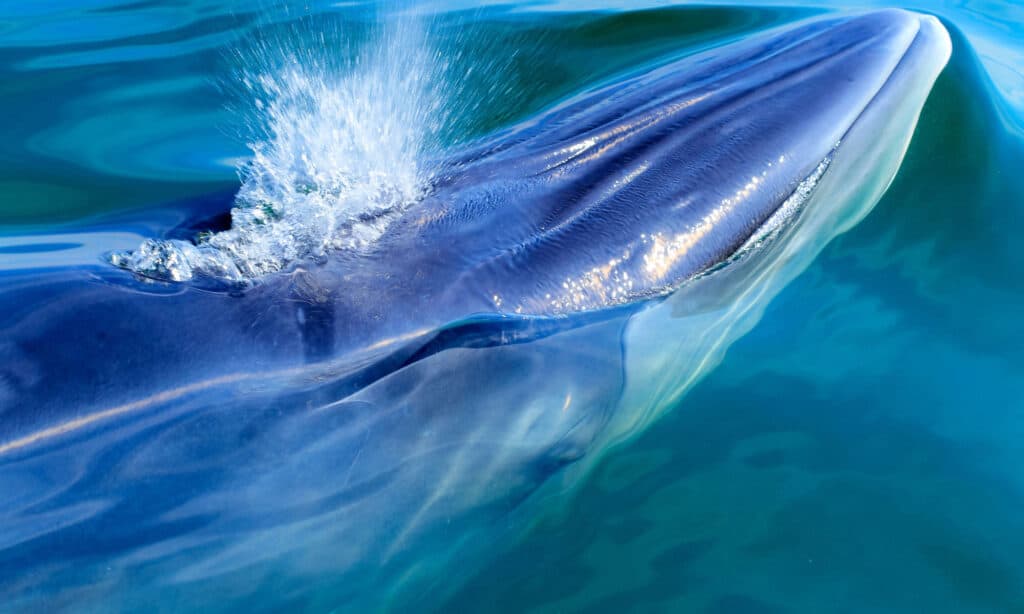
It is estimated that Bryde’s whales spend most of their days within 50 feet of the water’s surface.
©somsak nitimongkolchai/Shutterstock.com
The Bryde’s whale weighs approximately 50,000 pounds and reaches up to 50 feet long.
Sei Whale Size

The sei whale has a tall, sickle-shaped dorsal fin.
©Christin Khan, NOAA / NEFSC, Public domain, via Wikimedia Commons – License
The sei whale weighs up to 62,000 pounds and reaches up to 64 feet, even though females will be much bigger than the average sei male whale.
Minke Whale Size

Minke whales are the smallest member of the
baleen whale
family.
©Tim Watters/Shutterstock.com
The minke whale weighs anywhere between 10,000-28,000 pounds and reaches up to 35 feet long.
Other than the blue whale, the humpback whale outweighs each of these other members of his family. Now, let’s compare the humpback’s size to other animals and objects to give us a deeper appreciation for how large these whales are.
Humpback Whales Size Comparison to Other Animals and Objects
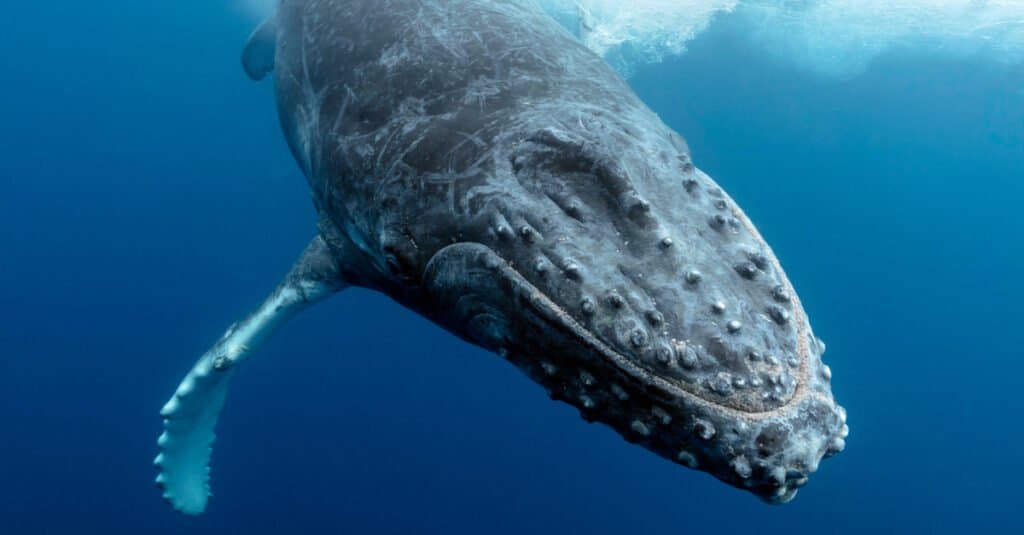
There are an estimated 80,000 humpback whales in the ocean.
©Craig Lambert Photography/Shutterstock.com
When we look at the size of a humpback whale weighing 80,000 pounds and reaching up to 62 feet long, it can be easy to get lost in those numbers and simply forget how enormous that really is! So let’s take a look at some objects that will be easy to compare their size to.
School Bus vs. Humpback Whale

A school bus is usually about 35 feet long.
©Michael O’Keene/Shutterstock.com
We can easily visualize a school bus and how long they are. A traditional school bus is typically 35 feet in length. Now, to get this compared to the humpback whale, we would have to imagine combining two school buses to equal the length of a humpback whale.
Semi Truck vs. Humpback Whale

A semi-truck will weigh 80,000 pounds fully loaded.
©James Steidl/Shutterstock.com
On the road, the vehicle we least want to get into a car accident with is usually a semi-truck, otherwise known as an 18-wheeler. These trucks usually weigh about 35,000 pounds empty. When they are fully loaded, they can weigh 80,000 pounds!
When we use this visual, thinking about how much humpbacks weigh is astounding. Oddly enough, vessel accidents are one of the main causes of death in humpback whales. And who could argue with that? When you think about an 18-wheeler slamming into a car and destroying it, we can only imagine the damage that would do to the actual whale.
Now that we’ve looked at some objects let’s compare how big the humpback whale is with other large animals!
Elephant vs. Humpback Whale
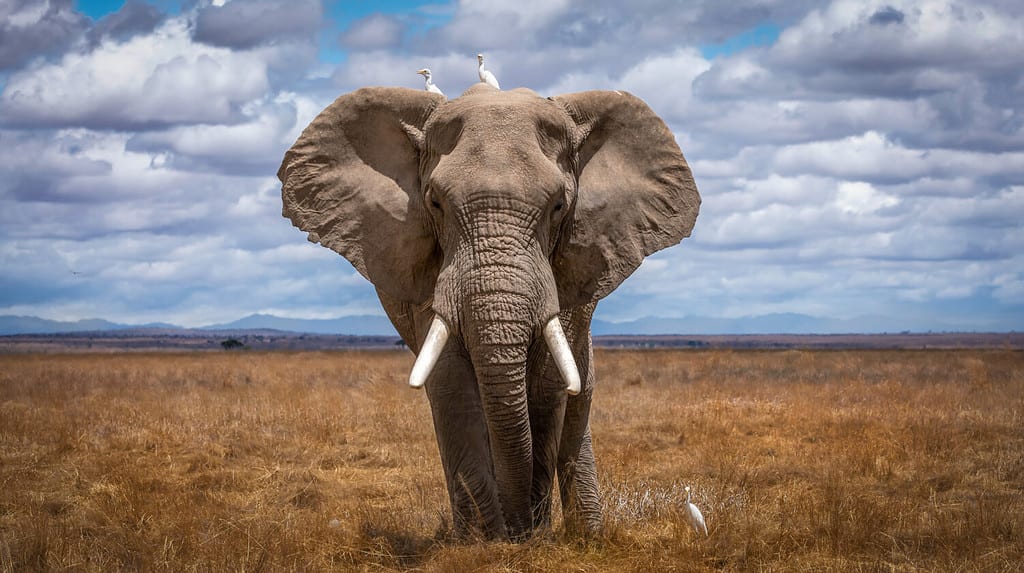
The
elephant
will spend 22 hours a day eating.
©Cautron Live/Shutterstock.com
The African Elephant is easily listed as one of the largest animals around the world. When you see other animals, or even humans, standing next to elephants, it is easy to see why they are considered one of the largest.
Elephants stand at 12 feet tall and can weigh more than 12,000 pounds. And the largest elephant ever to have been recorded stood at 13 feet tall and weighed twice that of a normal elephant, an enormous 12 tons (24,000 pounds)!
Even at the largest size of an elephant ever recorded, it doesn’t even come close to half the size of a humpback whale.
Hippopotamus vs. Humpback Whale

To stay cool in the blistering African heat, hippos spend most of their day in rivers and lakes.
©John Carnemolla/Shutterstock.com
While the hippo looks all cute and cuddly on TV and in movies, they are anything but small. These animals are astonishingly 16.5 feet long and can weigh over 9,000 pounds.
Now let’s imagine combining these two large animals. If we combine the hippo and the African Elephant, we are at a length of 28.5 feet and weighing 21,000 pounds which again does not even come close to the humpback whale being 62 feet in length and weighing 80,000 pounds!
Now that we’ve taken two animals that are most common when we think of large animals, let’s turn our focus to if the humpback whale is bigger than the blue whale.
Are Humpback Whales Bigger Than Blue Whales?
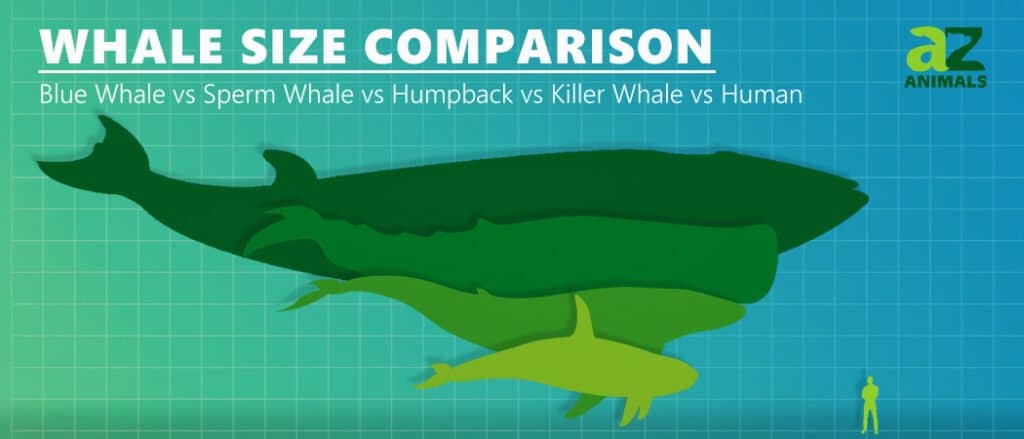
Let your curiosity get the best of you, and Google what the largest animal in the world is! Your search will quickly end as Google reveals that the blue whale is the largest animal alive.
As we saw earlier, the blue whale is actually a member of the same family that the humpback whale comes from, the Balaenopteridae family. While they may be in the same family, they are nowhere near identical in terms of size.
In remembering that the humpback whale weighs about 80,000 pounds and is 62 feet long, we now turn our attention to the blue whale, which weighs over 300,000 pounds and is over 100 feet long.
Oddly enough, not only are blue whales significantly larger than humpbacks, but they also outlive them, too. The blue whale’s lifespan is between 80 to 90 years, which is about 40 years more than the humpback living for up to 50 years.
The Largest Humpback Whale Ever Recorded
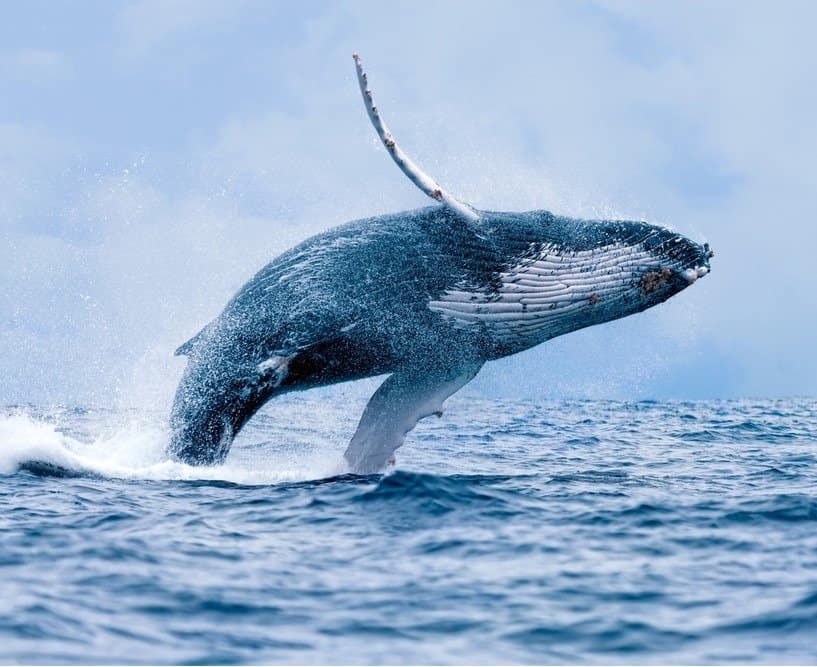
Humpback whales have a large white underbelly.
©Paul S. Wolf/Shutterstock.com
At the start of this article, we shared that humpback whales are usually 80,000+ pounds. We’ve seen in comparison with other animals and objects that these whales are absolutely gigantic. Just when we thought they couldn’t get any bigger, guess what? They can!
The largest humpback whale ever to be recorded was 89 feet long and weighed 180,000 pounds! Over twice the size of most humpback whales. We have heard this humpback whale being compared to that of five semi-trucks. And rightly so, given its vast size.
So the next time you find yourself whale watching, and if you are lucky enough to catch a glimpse of a humpback whale, take the time to share some amazing facts with your family and loved ones about this beautiful animal.
The photo featured at the top of this post is © anna sanfeliu gozalvez/Shutterstock.com
Thank you for reading! Have some feedback for us? Contact the AZ Animals editorial team.







